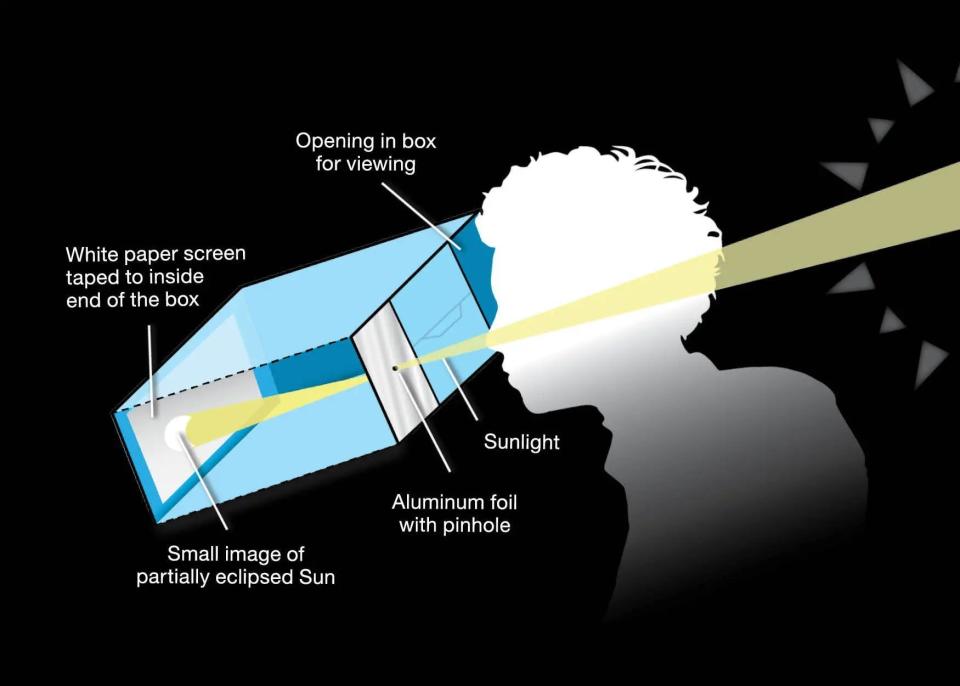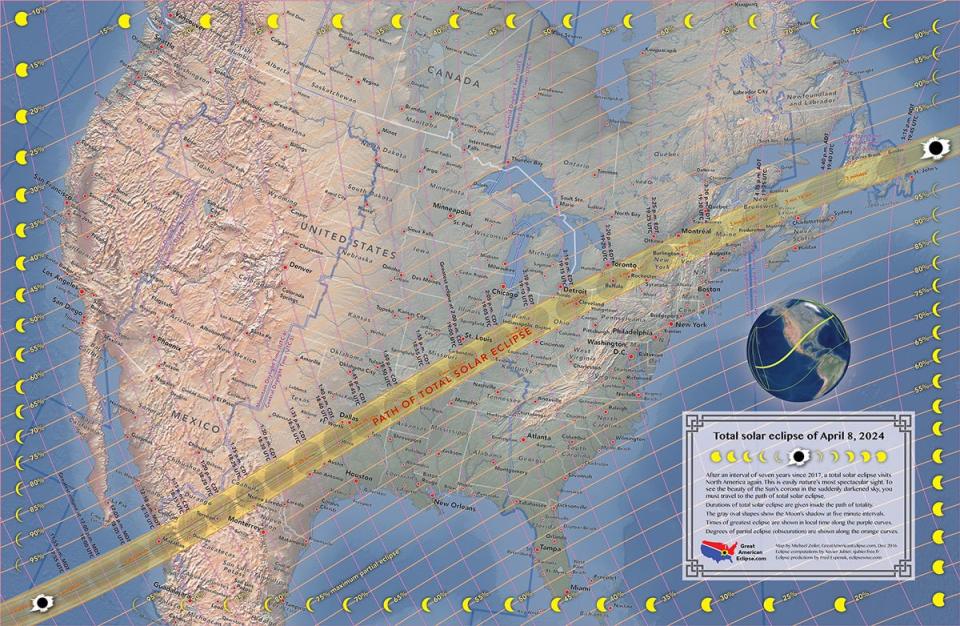Annular solar eclipse coming Oct. 14. Here's what you will be able to see in Florida
Time and date put into cellphone. Check.
Eye protection ordered or handy. Check.
Get excited. Double check.
An annular solar eclipse will be visible across portions of North and South America Oct. 14, and while Florida won't see the "ring of fire," we'll still be able to see the moon take a "bite" out of the sun.
Florida solar eclipse: Even without 'ring of fire,' social media takes these great photos
What is an annular solar eclipse?
An annular solar eclipse happens when the moon passes between the Earth and the sun while at its farthest point from Earth. That means the moon won't completely block the sun, according to NOAA.
The outer edge of the sun visible around the moon is the “annulus,” which is sometimes referred to as the “Ring of Fire” effect.
When is the annular solar eclipse?
The solar eclipse will occur on Saturday, Oct. 14. NASA said the eclipse will begin in Oregon around 9:13 a.m. PDT and end in Texas around 12:03 p.m. CDT.
States outside the path of "annularity," which is where the moon covers the sun, will see a partial eclipse.
Where will be the best view of the annular solar eclipse?
This eclipse will create a path of darkness stretching from the Oregon coast to south Texas.
In the United States, the annular solar eclipse will begin in Oregon at 9:13 a.m. Pacific time and end in Texas at 12:03 p.m. Central time.
Can you see any of the eclipse in Florida?
Yes. While the moon won't move entirely across the sun, you will be able see the moon cover anywhere from 67 percent to 73 percent of the sun, depending on where you are in the state.
Ring of Fire: Great American Eclipse aka 'ring of fire' is in October. Will Florida see solar eclipse?
So what time will the eclipse occur where you live?
Eclipse2024 offers an interactive website to answer all your questions about what you'll see and when during the eclipse, all based on where you live.
In West Pensacola, the eclipse will start at 10:39 a.m. Central time. Residents will start to see the moon pass across the sun's surface at the 1 o'clock position. The maximum coverage will be at 12:11 p.m., when the moon will cover 73% of the sun.
In West Palm Beach, residents can expect the to see the eclipse begin at 11:56 a.m. Eastern time, again at the 1 o'clock position. Maximum coverage will be at 1:32 p.m., when the moon will block 65% of the sun.
Click on your city and you'll also be able to see a graphic representation of what the eclipse will look like where you are.
Want even more interactive views? Check out this other simulator from Eclipse2024.org.
Safety first: Protect your eyes if you'll be outside to view the eclipse
Staring at the sun for even a short time without wearing the right eye protection can damage your retina permanently and could cause blindness, called solar retinopathy, according to the American Academy of Ophthalmology.
Since the sun is never completely blocked by the moon during an annular solar eclipse, it is not safe to look directly at the sun.
Use special eye protection designed to look at the sun, which are thousands of times darker than regular sunglasses, according to NASA.
Looking at the sun through a camera lens, binoculars, or a telescope without a special-purpose solar filter does not protect your eyes.
Remember: eclipse glasses are not regular sunglasses. Even very dark sunglasses will not protect your eyes.
Safe solar viewers must comply with the ISO 12312-2 standard.
Annular solar eclipse: 'Ring of fire' solar eclipse is coming to US in October. Here's when (and where) you can see it.
What can you do if you don't have eclipse glasses?

A couple of options you can make, as suggested by NASA, include:
One way is to use a pinhole projector, which has a small opening (for example, a hole punched in an index card) and projects an image of the sun onto a nearby surface. With the sun at your back, you can then safely view the projected image. Do not look at the sun through the pinhole.
Make your own eclipse projector with a cardboard box, a white sheet of paper, tape, scissors, and aluminum foil. With the sun behind you, sunlight will stream through a pinhole punched into aluminum foil taped over a hole in one side of the box. During the partial phases of a solar eclipse, this will project a crescent sun onto a white sheet of paper taped to the inside of the box. Look into the box through another hole cut into the box to see the projected image.
Livestreams of annular solar eclipse
I you can't be outside to watch in person. There are livestream options.
NASA will broadcast telescope views of the annular solar eclipse from across the U.S. on its NASA YouTube channel. Listen to solar scientists and ask eclipse questions in the livestream chat using #askNASA.
Skywatching website timeanddate.com also will livestream the annular solar eclipse from start to finish with its livestream and live-blog with real-time progress reports and background information.
When will be the next annular solar eclipse?
The next annular solar eclipse that will be visible from the United States won't happen until June 21, 2039, according to NASA Solar System Exploration.
Better plan ahead. Alaska is the only state in the path.
What's the difference between an annular and total solar eclipse?
During a total solar eclipse, the moon is at it's closest point to Earth, which allows it to totally block out the sun's light.
During an annular solar eclipse, the moon is at its farthest point from Earth, so the sun provides an outline around the moon.
When is the next total solar eclipse?

On April 8, 2024, a total solar eclipse will cross North America, passing over Mexico, United States, and Canada.
The total solar eclipse will begin over the South Pacific Ocean. The first location in continental North America that will experience totality is Mexico’s Pacific coast at around 11:07 a.m. Pacific time. Totality is when the moon completely covers the face of the sun
The path of the eclipse continues from Mexico, entering the United States in Texas, and traveling through Oklahoma, Arkansas, Missouri, Illinois, Kentucky, Indiana, Ohio, Pennsylvania, New York, Vermont, New Hampshire, and Maine.
This article originally appeared on Treasure Coast Newspapers: Ring of fire, annular solar eclipse. Where, how, when to view Florida

